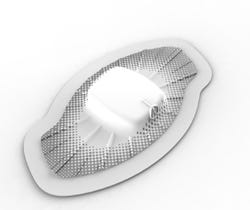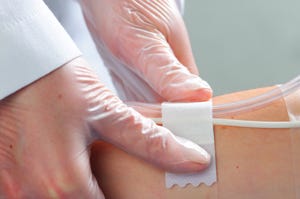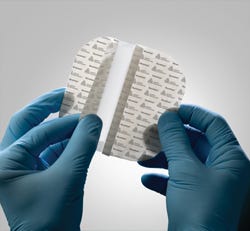Advanced skin-friendly technologies take advantage of the growing trend in caring for patients at home.

As healthcare costs increase, patients are spending fewer days in the hospital; the continuum of care is shifting to the home where patients with chronic conditions receive treatment and therapy as they resume their daily routine. An aging population also contributes to home healthcare’s growth.
|
The Metria patch-based wearable sensor technology platform is designed for consumer and clinical health management applications. It combines the latest advancements in sensors, electronics and software algorithms with skin-friendly adhesive technology. All photos courtesy of Avery Dennison Medical Solutions. |
This trend is expected to accelerate and has spurred the development of next-generation medical technologies specifically designed for, or easily adaptable to, the home healthcare setting. These advancements accommodate the lifestyles of home-based patients, who tend to have higher activity levels and fewer restrictions than hospital patients.
The new solutions, which often incorporate skin-friendly adhesive technologies, include wearable sensors, wound care dressings, and securement devices. These enable medical device suppliers and medical service companies to enhance their product offerings to more effectively meet the needs of the home healthcare sector.
Remote Patient Monitoring
Wearable sensors are an increasingly important part of the home healthcare sector. As remote patient monitoring technology improves and new applications emerge, the wearable sensor market is expected to grow rapidly. According to ABI Research Inc., about 80 million wearable sensors will be in use for health-related applications by 2017, an eight-fold increase over 2012.
A new patch-based wearable sensor technology platform is designed for clinical and health management applications. It combines the latest advances in sensors, electronics, and software algorithms with skin-friendly adhesive technology. Several key objectives drove the new platform’s design and development. The top priority was to demonstrate clinical effectiveness. Additionally, it had to be feasible to manufacture and fit within the existing medical industry reimbursement.
The platform is expected to support a family of patch-based wearable sensors for home healthcare applications. The monitors attach comfortably to the user’s skin using advanced adhesives and continuously collect physiological data including heart rate, body temperature, and other vital signs. The stored data is then wirelessly transmitted to computers or mobile devices to provide a snapshot of the user’s health and physical condition.
The platform’s first patch-based wearable sensor will enter the market in late 2012. The device is equipped with multiple sensors that collect more than 5,000 data points per minute. Initially, it is intended as an evaluation tool for weight management and will track lifestyle indicators such as steps taken, calorie expenditures, and activity levels.
The wearable sensor is the fruit of an extensive design engineering effort. The device’s adhesive presented an especially difficult challenge. There were several exacting requirements. The adhesive had to be gentle yet strong, to minimize the potential for discomfort or irritation upon removal, and to ensure user confidence and quality of life during wear. It had to perform by staying in place during daily activities. To meet these requirements, a custom-designed skin-friendly adhesive formulation was created.
A foam substrate carries the adhesive and provides a waterproof enclosure for the device’s electronics—a battery, ASIC and memory, and ECG. In addition to its sophisticated design and functionality, the patch-based wearable sensor has a low profile and can be worn comfortably and inconspicuously.
Wellness Programs
Potential additional applications for the patch-based wearable sensor include wellness programs, which are becoming increasingly popular. Primary care physicians who offer wellness services can have their patients wear the device continuously for a full week and then review the data collected. The data reveals the patient’s activity levels and vital signs at various times and while conducting different activities. It gives the physician an overview of the patient’s overall health and cardiac fitness to inform behavioral modification for patients who are overweight or prediabetic.
|
The BeneHold tube fixation device effectively secures multiple medical tubes, lines or cords in one device. The hook-and-loop closure system allows temporary or permanent fixation and repositioning of tubes and lines without removal and retaping. |
Acute and Chronic Care
Advanced remote monitoring technologies, such as the patch-based wearable sensor could also be used for acute and chronic care applications. In the acute care category, wearable sensors can be used to monitor patients for health problems prior to surgery or to monitor postoperative (post-op) patients during recuperation.
Consider cardiac patients recuperating at home after surgery. Studies show that more than 20% of post-op cardiac patients are readmitted to the hospital within 30 days of release.1 Reasons include excessive anxiety following surgery, and failure to take medications and follow other postsurgical guidelines. Fitting patients with wearable sensors can allow surgeons to monitor vital signs remotely, offering reassurance to patients and their families, while also helping to reduce the likelihood of hospital readmissions.
In the chronic care category, patients suffering from diseases such as congestive heart failure could be candidates for remote monitoring. This method could reduce the number of home visits by nurses or other care providers, and contribute to lower costs.
Wearable sensors are certain to gain greater functionality in the future. Research efforts are currently focusing on expanding the number of physiological vital signs that can be monitored. One example is blood pressure, which remains difficult to measure without the conventional armband cuff. Research suggests, however, that it may soon be possible to gauge blood pressure directly using wearable sensors or indirectly by measuring a surrogate sign that gives a good indication of blood pressure.2
Advanced Wound Care
New varieties of sterile absorbent wound dressings can benefit patients suffering from chronic wounds including pressure ulcers. One family of dressings that is anticipated to launch in Q3 2012 exhibits superior fluid handling capacity versus comparable commercial dressings. The dressings are constructed of a self-adherent wound contact layer and a water-resistant polyurethane top film. The wound contact layer absorbs wound exudates and transforms into a soft gel that protects against dehydration and facilitates conditions conducive to healing. The high fluid handling capacity of the dressings support moist wound healing, without causing skin maceration.3
The dressings’ rounded corners help prevent edge lift, which can compromise a dressing’s protection against bacteria and other contaminants. One of the dressings is transparent and provides easy wound visualization without removing it. The dressings are designed for the management of lightly to moderately exuding wounds. They come in various formulations and thicknesses to suit different wound types and exudate conditions. For example, patients suffering from wounds to the lower back (sacral) area can use one that is specially designed to fit that area’s curvature. Other dressings are specially formulated to capture odor molecules to help increase patient comfort and confidence.
|
The high fluid handling capacity of the BeneHold absorbent wound dressings support moist wound healing while minimizing the risk of skin maceration. |
Securement Devices
New securement products feature skin-friendly adhesives, which is ideal for home healthcare. They can be used to further secure dressings to the patient, and affix and organize tubes and lines. The product designs support long-term wear and are conformable for enhanced patient comfort and mobility.
Medical Tape Strips
The securement innovations include new patent-pending medical tape strips on a sheet. These are highly breathable strips of paper tape that feature latex-free acrylic adhesive. The strips adhere well to dry or slightly moist skin and are designed to minimize the risk of skin maceration or damage.
The tape strips are an alternative to conventional roll tape, which is one of the few medical products commonly reused without sterilization. Roll tape is prone to bacterial contamination and is a possible source of infection.4 It is often left on counters and tables, touched without gloves, and shared between patients and clinicians.
In contrast, tape strips allow the care provider to select and handle only the amount of tape needed for the procedure. This practice reduces tape waste and helps address infection concerns. The tape strips are supplied on perforated sheets that can be divided in half or quarters as needed. The tape strips have an adhesive-free tab at both ends to facilitate easy handling and a clean application of tape.
The medical tape strips offer a variety of uses in the home healthcare setting, such as securement of tubes, lines, or dressings to the patient, as well as immobilization of fingers or toes.
Universal Tube Fixation Device
Patients receiving treatment at home often have a number of medical tubes, lines, or drains that require securement and organization. During infusion therapy, for example, medication or fluids are administered via needles or catheters. Long-term infusion therapy increasingly takes place in the patient’s home to reduce costs and allow the patient to continue daily activities.
|
The BeneHold medical tape strips allow a care provider to bring into the patient care area only the amount of tape needed for the procedure. This helps reduce tape waste and address infection control concerns. |
The same is true of patients receiving negative pressure wound therapy. The therapy is intended to reduce tissue swelling and promote the healing of certain types of chronic wounds. In these and similar applications, tube fixation devices can be helpful to patients and care providers. One such fixation device effectively secures medical tubes, lines, and drains. The device has a special hook-and-loop closure system that allows temporary fixation and repositioning of tubes and lines without removal and retaping. The closure system also features an adhesive zone that offers permanent fixation of tubes or lines to prevent movement. The tube fixation device lifts tubes and lines off of the patient’s skin, reducing the risk of pressure points or skin abrasion. The device has an absorbent hydrocolloid adhesive that is gentle to the skin and can be removed without irritation. It can be used with IV catheter lines, epidural lines, Foley catheter tubes, urinary drainage tubes and surgical drain lines.
Conclusion
The recent advances in adhesive-based medical disposables and wearable sensor technologies are expanding the offerings of medical device suppliers and medical service companies, enabling them to provide more effective solutions for home healthcare applications. The solutions accommodate the active lifestyles of today’s home-based patients, while supporting overall efforts to reduce hospital stays and readmissions, which helps to contain costs. These products facilitate the monitoring of patients preparing for or recuperating from surgery, and help home-based patients and their caregivers successfully manage the treatment of chronic wounds and other long-term conditions.
In the years ahead, with the shift of more medical care and oversight to the home, the pace of change is expected to accelerate. Home healthcare professionals will need disposable medical products that are more effective and easier to use to help manage their care of patients in the home. Wearable sensors are well positioned to help patients at risk for chronic diseases such as obesity, diabetes, and heart disease increase their activity level and become more engaged in their own health and well being as part of preventative care efforts initiated by physicians.
References
W Boulding, et al., “Relationship Between Patient Satisfaction With Inpatient Care and Hospital Readmission Within 30 Days,” The American Journal of Managed Care 17 (2011): 41-48.
DD Baek and L Lading, “Cardiovascular Sensing,” Danish Technological Institute, January 2012.
GD Winter, “Formation of the Scab and the Rate of Epithelialisation of Superficial Wounds in the Skin of the Young Domestic Pig,” Nature 193 (1962); 293-294.
DA Redelmeier and NJ Livesly, “Adhesive Tape and Intravascular-Catheter-Associated Infections.” Journal of General Internal Medicine 14 (1999).
Deepak Prakash is global market segment manager of wearable sensors at Avery Dennison Medical Solutions. He can be contacted at [email protected].
Emily Berlin is global market segment manager of advanced skin adhesives and antimicrobials at Avery Dennison Medical Solutions. Contact her at [email protected].
About the Author(s)
You May Also Like




.jpg?width=700&auto=webp&quality=80&disable=upscale)



